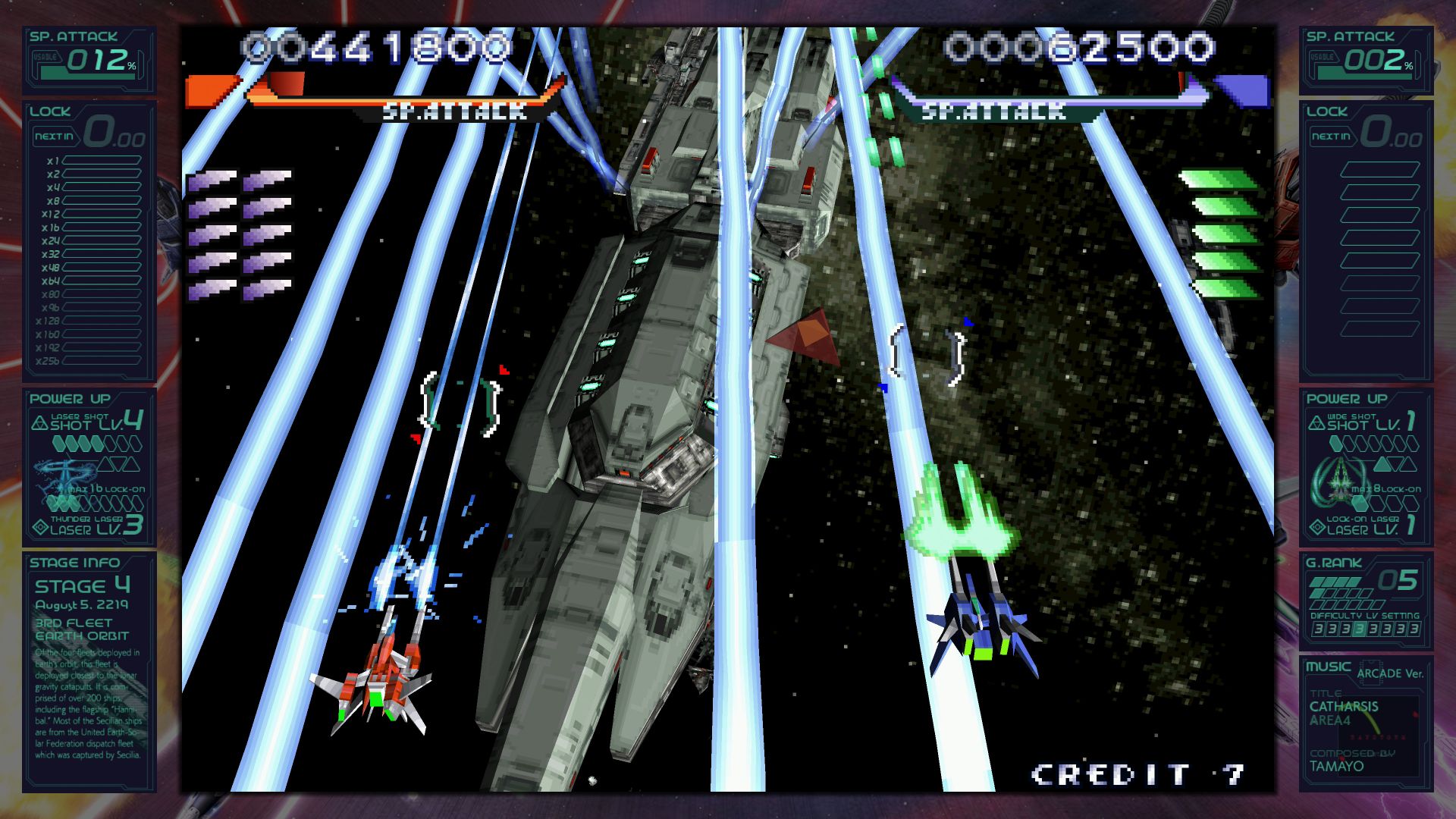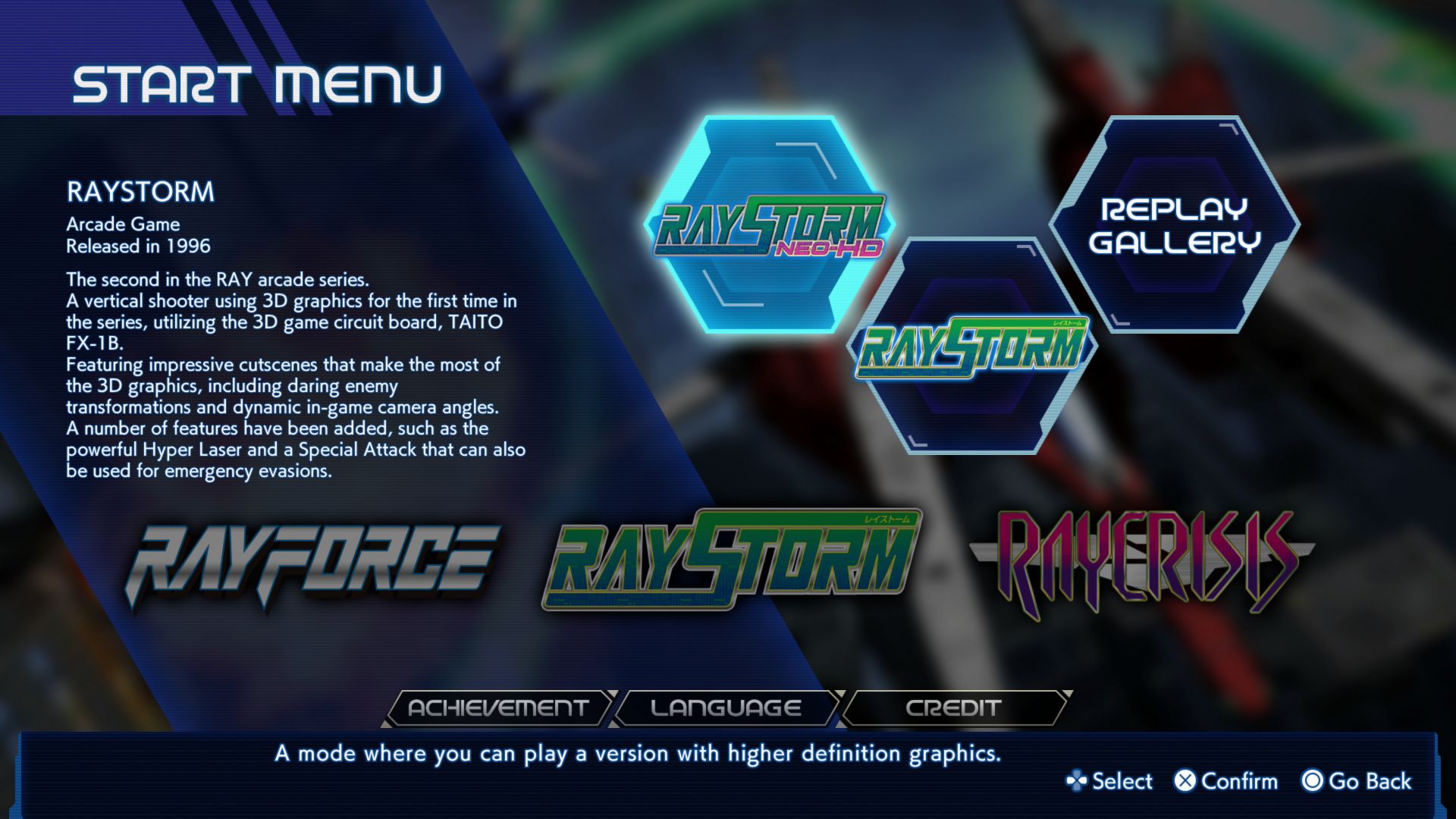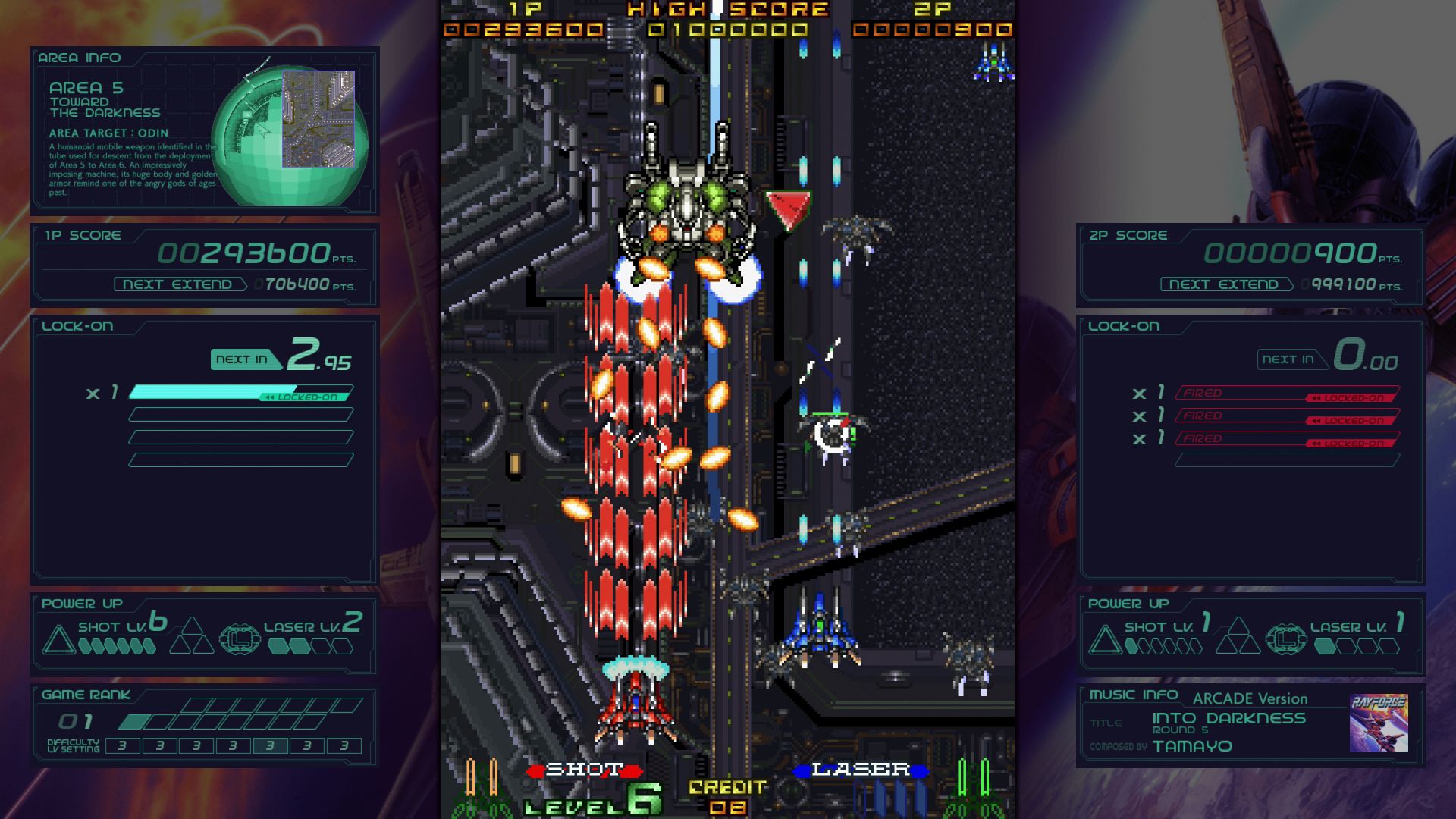

Taito’s “Ray” series of vertically-scrolling shoot ‘em ups hasn’t seen nearly as many entries as their Darius series, but it retains a devoted following among fans of the genre. Comprised of RayForce, RayStorm, and RayCrisis, the Ray games are known for their lock-on mechanics that allow players to fire upon enemies in the foreground and background, excellent ship and mecha designs, and memorable music. ININ and M2’s Ray'z Arcade Chronology for PlayStation and Switch celebrates and preserves the series by collecting all three arcade games in one simple but slick package.
The collections’ main menu is very simple, allowing users to choose from the three games, view the helpful in-game Achievement/Trophy list, select a language, and view the credits. Upon selecting a game, players can choose to launch the regular or HD version (RayStorm and RayCrisis only), or view any replays that have been saved. The actual gameplay and presentation options are accessible after launching a game. No historical information has been provided, which is a shame given the series’ slightly niche status.

Within each game, pressing either trigger opens the game-specific menu. From there, you can create or load a save state, read the helpful in-game manual, view online rankings, or change the game’s impressive array of options. Controls can be customized for both players. Display options allow the screen to be resized, smoothing and scaling to be toggled, and a choice of three widescreen borders or no border. Sound allows the selection of two different soundtracks for each game (original or arranged) and for the optional inclusion of ambient arcade noise. The background noise doesn’t appeal to me, but it’s a cool inclusion, nonetheless. Finally, optional “gadgets” display useful information about power-ups, area names, song titles, and more.
All three games in the collection support drop-in, drop-out 2-player local co-op.
RayForce

The first game in the series is 1994’s RayForce (also known as Layer Section and Galactic Attack), which originally ran on Taito’s F3 arcade hardware. RayForce is not included in the similar but cheaper RayStorm X RayCrisis HD Collection, so Ray’z Arcade Chronology is the version to get if you want to own the full series. RayForce, unlike the other two games in the collection, does not have an “HD” version. That said, the original blend of 2D graphics and 3D effects still looks quite impressive, arguably more so than the polygonal visuals of the sequels. The backgrounds are filled with all manner of intricate details, parallax layers, and visual techniques that create a greater sense of depth than those of other 2D shooters.
RayForce begins and ends without any cinematics, as far as I can tell. Despite that strange omission, the game manages to express a fair level of personality simply through its futuristic environments and enemies. Flying through Earth and space-based cities, clouds and canyons, and numerous technology-laden tunnels is a genuinely memorable experience. Toss in some huge, mechanized enemies, and you get an intriguing future setting.
RayForce also establishes the gameplay basics that the sequels will improve upon. Players can fire regular shots forward to hit enemies on the same plane, but enemies in the foreground must be defeated with lock-on lasers. The number of enemies that can be locked onto at once is relatively small in this entry but can be increased by collecting power-ups. Unlike many shooters of its era, RayForce has no bomb mechanic, so lock-on lasers factor heavily into gameplay. In fact, the lock-on mechanic is relied upon a little too heavily here for my taste, but the balance improves in the sequels.
RayStorm
1996’s RayStorm originally appeared on Taito’s FX-1B arcade hardware. After being ported to PSOne and Sega Saturn, it would later be released as RayStorm HD on Xbox 360 and PlayStation 3 in 2010. RayStorm Neo HD, the enhanced version of RayStorm included on Ray’z Arcade Chronology is NOT the full HD remake of the 360 era, unfortunately. This version’s “HD” option simply improves the ship and enemy models to a mild extent (as with G-Darius HD), whereas RayStorm HD for 360 fully remade and improved upon all of the visuals, including the backgrounds. It would have been great to get that version in this collection as well, but c'est la vie.
The rudimentary polygonal graphics of 1996 don’t spoil RayStorm, however; they’re part of its charm. The move to fully 3D graphics allows the developers to render even more dynamic backgrounds that incorporate new camera angles and tricks. This is best exemplified in the fourth stage’s incredible space battle. The entire level takes place among a vast armada of ships, with the camera swooping and zooming around as the fight unfolds. The game is full of exciting scenarios like that, and the music is the best in the series.
RayStorm’s mechanical improvements start with the inclusion of two selectable ships. Each has a different primary weapon, and one can lock onto twice as many targets as the other. Players can also choose between manual and auto-firing of the lock-on lasers – a great option. Finally, the new SP meter allows players to unleash a screen-filling special attack when fully charged.
RayCrisis
Although RayCrisis arrived in 1998, it’s actually a prequel to RayForce. The original arcade game ran on Taito’s G-NET hardware and boasts improved visual fidelity over RayStorm. This is best exemplified by increased use of 3D perspective and new dramatic camera pans at the beginning of stages. On the collection, this one has an “HD” option with the same minor improvements to ships and enemies as described before. Speaking of ships, the selectable ships return, and a new, third ship can be unlocked via code (necessary for a Trophy in this collection).
This installment has an increased focus on story, with a fast-paced and confusing introduction and three different endings. Reaching those endings depends on the new “Encroachment” system. The game itself is only five stages long (shorter than previous entries), but the middle stages are randomized, creating a different experience every time. The speed at which players defeat enemies and bosses contributes to the overall encroachment rating at any given time. Depending on the encroachment rating, players will see a different ending. Managing your encroachment well enough to reach the true final boss and get the good ending isn’t easy, so RayCrisis is less mainstream-friendly than its forebears.
Conclusion
Preserving classic games for future generations is important, so Ray’z Arcade Chronology is a necessary and welcome collection. It presents all three Ray games with excellent emulation and a fair number of options and minor enhancements. The only downside here is that some content from previous home releases is missing, resulting in a slightly incomplete presentation. The Xbox 360 version of RayForce HD is the biggest omission, but the extra modes from the PSOne and Saturn ports are absent as well. We don’t even get a boss rush here. ININ and M2’s G-Darius HD actually got updated with console content after launch a while back, so it’s possible that will happen with Ray’z Arcade Chronology as well. As it stands, this is a good collection, but a little high priced for what it contains.
Ray'z Arcade Chronology sells for $49.99 on PlayStation and Switch. Physical versions are available to preorder in limited supply at Strictly Limited Games.
A PlayStation download code was provided by the publisher for this review.